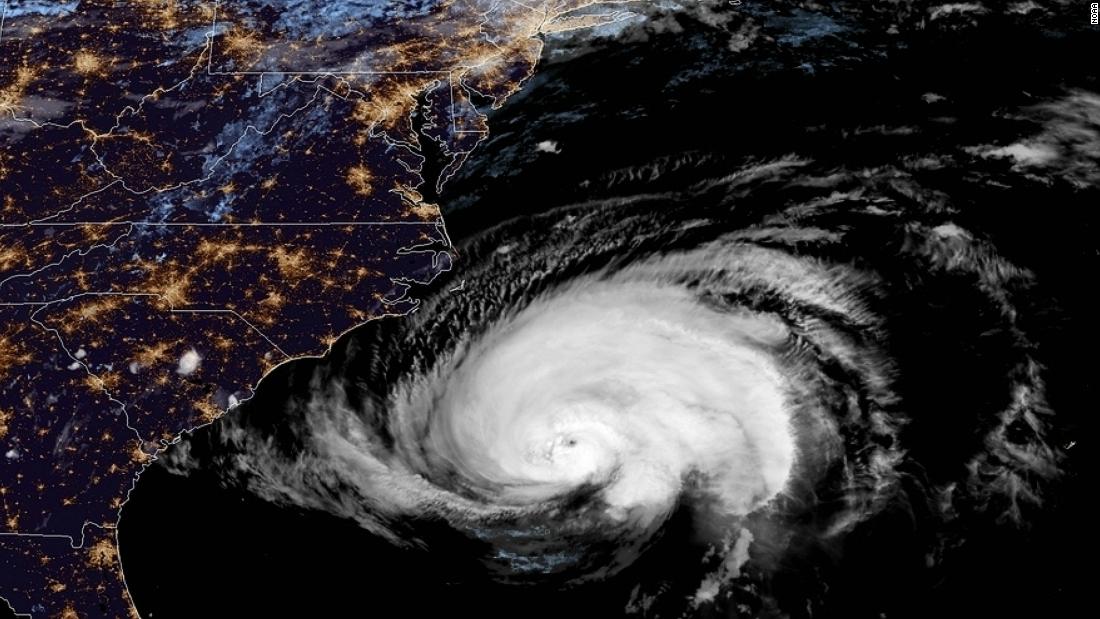[ad_1]
The Carolina coasts can expect winds topping 80 mph late Thursday afternoon. And that’s just the prelude to untold days of misery.
Don’t be fooled by the fact that Florence has weakened slightly to a Category 2 hurricane; categories only denote the speed of sustained winds. What makes this hurricane extremely dangerous are the deadly storm surges, mammoth coastal flooding and historic rainfall expected far inland.
“I don’t care if this goes down to a Category 1,” CNN meteorologist Chad Myers said. “We’re still going to have a Category 4 storm surge.”
Even worse: Florence is expected to hover over the Carolinas, whipping hurricane-force winds and dumping relentless rain at least through Saturday.
Latest developments
• Fierce winds and rain have started: “Rain bands with tropical-storm-force winds (are) moving onshore on the outer banks of North Carolina,” the National Hurricane Center said. Tropical-storm-force winds are between 39 and 73 mph.
• Florence is getting closer: As of 8 ET Thursday morning, the center of Florence was about 170 miles east-southeast of Wilmington, North Carolina, and about 220 miles east of Myrtle Beach, South Carolina.
• The path of the storm: Florence’s center will approach the North and South Carolina coasts late Thursday and Friday, but it’s unclear exactly when and where and it will make landfall. As the storm moves inland, Georgia, Virginia and Maryland will also be in peril.
• Storm surge is a huge threat: Strong winds will send rising water inland from the coastline of the Carolinas. The storm surge could rise up to 13 feet — that’s water inundating homes up to the first-floor ceiling, the National Hurricane Center said.
• Flight cancellations: At least 800 flights along the US East Coast have been canceled Thursday through Saturday ahead of the storm.
Millions flee or prep for chaos
Officials in the potential path of Florence urged people to evacuate their coastal homes and directed drivers away from the coast.
“You put your life at risk by staying,” North Carolina Gov. Roy Cooper said. “Don’t plan to leave once the winds and rains start.”
Up to 40 inches of rain could fall in North Carolina. Cooper and South Carolina Gov. Henry McMaster told more than 1 million people who were directed to leave that if they don’t evacuate, no one will come to save them.
“Even the rescuers cannot stay there,” he said.
In Carolina Beach, North Carolina, authorities have stopped allowing traffic to the island via the only bridge between the island and the mainland. They also instituted a 24-hour curfew. The town is less than 5 feet above sea level and officials worry that as many as 1,000 of the town’s 6,300 residents are planning to stay.
Mayor Joe Benson said the storm will batter the oceanside town through two high-tide periods. Storm surge of 13 feet on top of a high tide at 7 feet could overwhelm Carolina Beach.
“Our sand dunes are healthy, but they’re not going to be able to keep back a wall of water like that,” he said. “Flooding is almost guaranteed.”
Susan Faulkenberry Panousis has stayed in her Bald Head Island, North Carolina home during prior hurricanes, but not this time. She packed up what she could and took a ferry.
“When that last ferry pulls out … it’s unnerving to see it pull away and know, ‘That’s the last chance I have of getting off this island,'” she said Wednesday.
Emergencies declared in several states
Officials in several states have declared states of emergency, including in the Carolinas, Georgia, Virginia and Maryland, where coastal areas are still recovering from summer storms.
Florence’s expanse even captured the attention of the astronauts and cosmonauts aboard the International Space Station, who have been tweeting pictures of the storm back to Earth.
“Watch out, America! #HurricaneFlorence is so enormous, we could only capture her with a super wide-angle lens from the @Space_Station, 400 km directly above the eye,” German astronaut Alexander Gerst tweeted. “Get prepared on the East Coast, this is a no-kidding nightmare coming for you.”
CNN’s Kaylee Hartung, Jason Hanna and Steve Almasy contributed to this report.
[ad_2]
Source link





